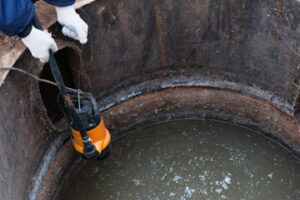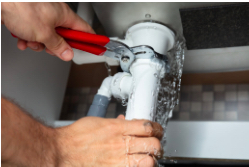A sump pump is a device installed in the lowest part of your home, often the basement or crawl space, to keep it dry and prevent costly flooding. Knowing where water, sewer, and utility lines enter your house is important before having a sump pump installed.
It is also a good idea to install a backup battery or emergency pump so your house can stay dry even if the power goes out. However, if you need assistance from experts, you can call Plumbing Express, Inc..
A sump pump is a great addition to any home, but it’s important to make sure the pump is installed properly and that the discharge pipe leads water away from your house—not toward it. This is especially true during rainy seasons when the potential for flooding increases. A professional can help with the installation process and ensure everything is in working order.
A plumber will need to dig a pit in the lowest part of the basement or crawl space where the sump pump will be located. The pit should be large enough to fit the pump and have six inches of gravel in it. The plumber will also need to locate an exit point on the side of the house where the discharge pipe will lead. The pipe should go down the side of the house and into the yard and travel far enough away from the house so that floodwater won’t flow back into it.
Installing a discharge pipe isn’t easy. The plumber may need to drill through the siding and rim joist in order to place it in the correct location. It’s important that the pipe is positioned so that it can handle the volume of floodwater that the pump will need to discharge. The discharge pipe should also be positioned so that it won’t get blocked by ice and snow in the winter.
Once the drainage system is installed, it’s time to install the pump itself. A plumber will need to follow the instructions that came with the pump, which will typically include adding a check valve near the pump to prevent it from sucking up water back into it. The plumber will then need to connect the pump to the discharge line with PVC piping.
It’s a good idea to have a battery back-up power source for the sump pump. This will help protect your home from flooding if the main power source fails—which often happens during heavy rainstorms, especially in the Midwest. A backup battery will cost extra, but it’s well worth the investment if you want to protect your home from damage and ensure that the water can be evacuated quickly and safely.
Repairing a Sump Pump
If your sump pump doesn’t work as it should, you’ll be exposed to flooding and dampness that can damage your home, ruin your belongings, and put your family’s health at risk. Whether it’s from an unprotected basement or excessive rain, moisture can promote mold that causes allergies, respiratory problems and other illnesses. A sump pump helps protect you from these problems, but if your sump isn’t working, you’ll need to call us for sump repair services.
Several issues may be keeping your pump from operating properly. The most common issue is a power outage. If your sump doesn’t have power, it can’t run and will not pump water out of your basement. This is why you should always keep a backup generator or battery-powered back-up handy to kick in during storms when electricity goes out.
Another common reason a sump pump doesn’t operate is that the impeller is choked by debris or is otherwise damaged. A sump’s screen is designed to keep out large items, but occasionally something can get past the screen and into the impeller. This causes it to screech and rattle, which can cause the pump to shut off before it’s done working. If you hear these noises, we’ll be happy to clean the impeller and reassemble your pump to see if this fixes it.
We also can take a look at the pit to see what’s in it. The air gap is an important part of the sump system to prevent sewer and water lines from entering the basement, but it can become clogged with dirt or debris over time. We can inspect the pit, clean it out, and ensure that the air gap is functioning properly.
In addition to ensuring your pump has enough power, we can also check to make sure that it’s plugged in correctly and that it has a GFCI outlet. Because sump pumps are located in wet areas, they’re prone to electrical problems that can trip a GFCI outlet or a circuit breaker. Many times, simply pressing the reset button will restore power to your sump pump.
Maintaining a Sump Pump
Sump pumps can help to protect the basement or crawl space of your home from water intrusion, mold and wood rot. They are also useful for preventing groundwater from seeping in and damaging the foundation of your house. However, like any piece of machinery they will require routine maintenance in order to function properly. This is especially true in humid areas. A plumbing professional should perform this service once a year or so, preferably before the first heavy rains of the season.
The professional will inspect the pump to make sure it is able to discharge the maximum amount of water it was designed for. The pit it sits in should be free of debris and the sump pump inlet screen will need to be cleaned. The pit should also be large enough to allow for effective drainage. The check valve in the discharge pipe will be inspected to make sure it works automatically. Sometimes the check valve is installed incorrectly and it is unable to prevent water from flowing back into the pit when the sump pump turns off. The professional will also determine whether a backup power source is in place and that it is functioning properly.
Finally, the pump bearings will be inspected and checked to see if they need lubrication. Some models of sump pumps use sealed bearings and do not require any lubrication at all. Other models will need the pump oiled with grease. The professional will consult the owner’s manual to see what type of lubricant is recommended.
A loud screech or rattle from the pump’s motor could indicate that it is overworked. It may also mean that the impeller is choked by debris or that the discharge pipe is frozen.
The professional will unplug the pump and remove it from the basin for inspection. He or she will then clear away any debris from the pit and clean the inlet opening or screen. The pump will then be reinstalled and plugged in. Five gallons of water will then be poured into the basin to verify that the float switch moves correctly and activates the pump when necessary.
Replacement
Sump pumps are essential in areas prone to flooding or in homes built below the water line. They collect stormwater, sewage and melting snow and pump it away from your home before it can cause serious damage or flooding.
The main function of a sump pump is to prevent basement and crawl space flooding from heavy rains, thunderstorms or rapidly melting snow. The pumped water is taken through pipes to a drainage point several feet away from the home. It’s then discarded safely.
A sump pump can also prevent mold, wood rot and pests from invading under your home. These can lead to expensive structural damage and health problems for your family. They can also release toxins into the air that can trigger allergies, asthma and other respiratory complications. Sump pumps help keep these pests and toxins out of your home, providing added protection for your family’s health.
If your sump pump is leaking or unable to turn off, it may need replacement. Leaking pumps can be caused by a number of issues, including clogged valves or cracks in the pipe. A plumber will examine your pump, find the source of the leak and take action to resolve it.
Installing a new sump pump can be fairly straightforward. Start by determining where the plumbing, sewer and utility lines enter your home. Then, make sure the sump pit is at least 8 inches (20 centimeters) away from these lines and close to a GFCI outlet. Next, measure and cut the length of discharge pipe you need to attach to your pump. Then, attach the new pipe to the discharge outlet on your sump pump using a male adapter. Use purple primer and PVC glue to ensure a watertight seal. Connect the other end of the pipe to a drain valve in your basement and run it up through a rim joist to the outside.
If you’re installing a sump pump in your crawl space, be aware that access can be limited due to tight spaces. You’ll need to install the pump in a spot that’s easy to reach and doesn’t require digging or moving existing pipes.


